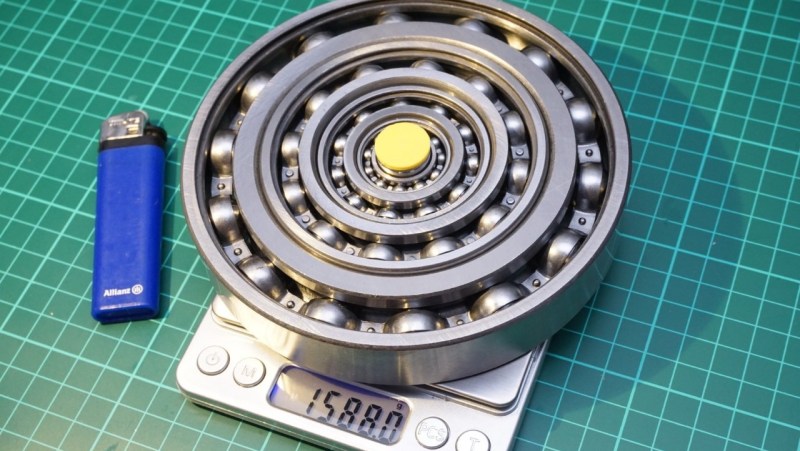People who know about bearings go through a phase of bemusement with regards to fidget spinners. We say something like, “man, I got a whole box of bearings in the basement.” Then we go through a “OK, I’ll make one” phase and print one out of PLA.
[fishpepper] took that sentiment a step further. After being forced to print spinners for his kids, he got jealous and decided to make his own—but his spinner would be a version for engineers. [fishpepper]’s ginormous spinner consists of five bearings superglued inside each other, with the grease cleaned out of the insides to make them spin faster. The inner two sets are doubled up bearings, 6 mm x 17 mm x 6 mm and 17 mm x 30 mm x 7 mm. The middle bearing measures 30 mm x 55 mm x 13 mm, and the fourth bearing 55 mm x 90 mm x 18 mm.
If you want to stop here, it’s a good size, around two inches across. However, [fishpepper] took it a step further, adding a fifth bearing, a 90 mm x 140 mm x 24 mm monster weighing in at 1 kg by itself. The total weight comes to 1.588 kg with the 3D-printed hub included. If you want to make one yourself, check out [fishpepper’s] bearing-in-bearing spinner tutorial which guides you through the various steps.
Hackaday likes fidget spinners so much you’d think we were in 6th grade: we’ve published posts on the three-magnet spinner hack, a fidget-spinning robot, and teaching STEAM with fidget spinners.
















Spinception?
WOW this video is a good example of camera aliasing.
That is not a fidget spinner it is a squirrel bearing, completely nuts.
*A lot
This is the first spinner that I actually enjoy the thought of replicating.
Just make sure you lube it up first or you’ll never get it off again.
Instructions unclear; 11th digit stuck in fidget.
By the end, only the innermost bearing is spinning. You’d get the same result from just using a single bearing with a 1.5 kg flywheel on it. It does look cool, though.
Given that only the innermost bearing actually needs to work well as a bearing, maybe auto repair shops would soon be getting calls from Hackaday readers wanting to buy worn out bearings for a small fraction of the new price but significantly more than scrap value?
Also most of those press fits need some loctite 609.
or just better fitting bearings.
The next logical step in the evolution of the fidget spinner is: the gyroscope.
Including versions with a built – in motor to get high speeds.
Look to your old hard drives with 10,000 rpm motors for inspiration.
Close enough…
http://www.dynaflexpro.com/product-e-sportsproplus.html
Powerball?
Need a motorized bearing – a bearing with built in motor that spins the outer ring relative to the inner one (sort of like the motorized zoom/focus rings on DSLR lenses). Then by stacking them like this you could potentially reach high speeds on the outermost ring.
Yo Dawg…
From here it’s bearings all the way down. Hill.
On what day can we expect to stop seeing posts (on the internet as a whole) about fidget spinners?
I’d like to mark it on my calendar.
July 18……. 2027
Zhere are many ways to fix ze problem.
Firstly, post constructive…posts, on articles that you like while avoiding anything involving spinners. Make each message constructive to provoke thoughtful responses, or just troll and people will respond anyway it doesn’t really matter…
Secondly, improve morale.
This is paramount; fidget spinner articles will continue until morale improves.
Thirdly, we wait until this fad passes over. Just like Nickelback and CrystalPepsi, eventually the populace realizes how terrible they are and begins shunning such horrible products.
Also, here’s a great tool:
https://hackaday.io/project/8066-responsible-media-consumption
Add your own blacklist, and make Hackaday great again.
> Just like Nickelback and CrystalPepsi, eventually the populace realizes how terrible they are and begins shunning such horrible products.
Worked for BMX and skateboards!
Just install a word/string replacer plugin in your browser and enjoy “useless crap” everytime you would usually stumble over theese stupid wastes of energy.
A 3d printed (presumably plastic) inner hub seems like a fairly fragile thing given the potential weights, speeds and forces likely to be involved here. A failure of that at speed could be rather problematic.
At some point only the inner bearing spins and the other one are just there for the mass.
I bet you could get a better spinner if you would replace the outer bearings just with metal disks.
I see no 555 was involved :(
I own the scale in the picture lol.
Still why the hype with “fidget spinners” I find it obnoxious.
Also should have used some loctite 609. Those are not exactly a tight press fit.
What was the lighter for???
He didn’t have any bananas.
showing the german readers, that he is german :D Allianz is an insurance company
Now lets see one made with MAGNETIC bearings…
Bearings are straightforward device aspects yet are important for activity applications.
What a monster is that